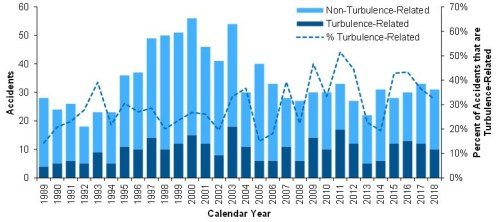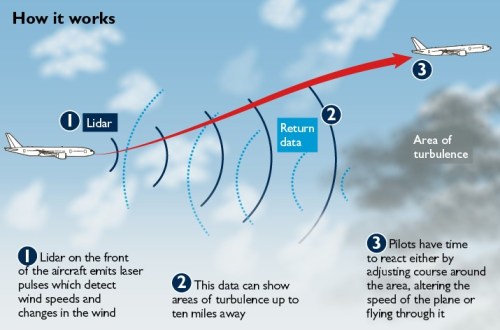 An article on the British Broadcasting Corporation (BBC) website makes the claim that clear air turbulence (CAT) is getting worse, affecting airline flights, and the culprit is climate change.
An article on the British Broadcasting Corporation (BBC) website makes the claim that clear air turbulence (CAT) is getting worse, affecting airline flights, and the culprit is climate change.
This claim is demonstrably false. Data from actual airline flights shows no increase in turbulence. [emphasis, links added]
The BBC article, “Flight turbulence increasing as planet heats up – study,” by reporter Maddie Molloy says:
Scientists at Reading University in the UK studied clear-air turbulence, which is harder for pilots to avoid.
They found that severe turbulence had increased 55% between 1979 and 2020 on a typically busy North Atlantic route.
They put the increase down to changes in wind speed at high altitudes due to warmer air from carbon emissions.
“Following a decade of research showing that climate change will increase clear-air turbulence in the future, we now have evidence suggesting that the increase has already begun,” said Prof Paul Williams, an atmospheric scientist at the University of Reading who co-authored the study.
The claims are based on a study, published in Geophysical Research Letters, titled Evidence for Large Increases in Clear-Air Turbulence Over the Past Four Decades.
But, there’s a problem – the study failed to examine any actual airline turbulence event data to determine whether CAT incidents have increased – instead, they relied on data reanalysis and modeling of the atmosphere to make their claim.
Actual flight data presented in previous Climate Realism posts here, here, and here, for example, refutes computer model simulations, which suggest flying conditions are worsening due to turbulence.
The scientists cited by the BBC completely ignored a 2021 report by the International Civil Aviation Organization (ICAO) that plotted accident data related to turbulence, finding no statistically significant increase since 1989, despite a tremendous increase in passengers and miles flown. See Figure 1 below:

If CAT had increased due to climate change as the study claims, there would be a clear upward trend demonstrated in the graph. Instead, the values of turbulence-related aircraft accidents have held steady since about 1995 as seen in Figure 1.
The ICAO accident graph agrees with what was found in Climate at a Glance: Deaths from Extreme Weather. From that publication comes these facts:
The Intergovernmental Panel on Climate Change (IPCC) AR6 report, Chapter 11, Weather and Climate Extreme Events in a Changing Climate, concludes that changes in the frequency and intensity of most severe weather events have not been detected nor can they be attributed to human-caused climate change.
Real-world data shows that there has been no increase in drought or heat waves; no increase in flooding; no increase in tropical cyclones and hurricanes; no increase in winter storms; and no increase in thunderstorms or tornadoes, or associated hail, lightning, and extreme winds from thunderstorms.
The point here is that CAT occurs from changes in the jet stream and weather fronts, short-term events to which the IPCC says it is unable to attribute any changes as a result of human-caused climate change.
Even if CAT was increasing, new technology is being introduced to spot it and avoid it.
For example, Boeing, the world’s leading commercial aircraft manufacturer, has been doing tests with a laser-based radar (LIDAR) on passenger aircraft.
The system, seen in Figure 2, was developed by the Japan Aerospace Exploration Agency (JAXA), and has a good lead time for the detection of CAT:
JAXA had successfully developed the onboard system that weighs only 83.7 kilograms, which is equivalent to a passenger with one baggage, but boosts the world’s longest range of 17.5 kilometers in detecting clear-air turbulence ahead of the aircraft.
A 17.5 kilometer means roughly seventy seconds for cruising aircraft, during which pilots can turn on the seatbelt sign to make advanced warning for passengers and crews to prepare for hazardous shaking. The system can potentially reduce turbulence-caused injuries by sixty percent.

The bottom line is data from the ICAO, the authority on global civil aviation, refutes claims that climate change is producing more flight turbulence.
In addition, the IPCC has not indicated atmospheric turbulence is increasing. Also, even if turbulence was increasing, new LIDAR technology will help keep airline travelers safer.
Increasing flight turbulence is a non-existent problem outside of computer models. Unfortunately, model projections supporting claims of a climate crisis seem to be the only thing the BBC cares to report on when the question is climate change.
As shown in similar BBC stories, Should we give up flying for the sake of the climate? and What would a flying-free world look like?, the BBC’s writers seem to feel that seeking out data or evidence falls outside their role as journalists.
The evidence suggests that this is just one more in a growing line of BBC climate scare stories attempting to scold or scare people into not flying.
Top photo via Pixabay
Read more at Climate Realism



















BBC is becoming just the UK version of CNN total leftists propaganda